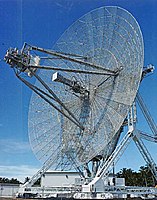
Photo from wikipedia
Coherence-based synthetic aperture radar (SAR) tomography (TomoSAR) exploits the complex coherences of SAR images to achieve 3-D imaging. Utilizing two-sensor spaceborne SAR formation flying to realize coherence-based TomoSAR has attracted… Click to show full abstract
Coherence-based synthetic aperture radar (SAR) tomography (TomoSAR) exploits the complex coherences of SAR images to achieve 3-D imaging. Utilizing two-sensor spaceborne SAR formation flying to realize coherence-based TomoSAR has attracted increasing attention because temporal decorrelation-free interferograms can be constructed; therefore, TomoSAR has excellent potential for inverting the vertical structures of natural scenes such as forests and glaciers. However, low earth orbit (LEO) TomoSAR is disadvantaged by limited data and nonuniform sampling in the elevation direction. Geosynchronous (GEO) TomoSAR can overcome these limitations owing to its short revisit time of no more than 24 h. For the first time, this article discusses coherence-based TomoSAR exploiting GEO SAR formation flying. The benefits of GEO-formation coherence-based TomoSAR, including the low cost of slave satellites, rich data sets, and uniform sampling, are noted. The key problems of system design, including the formation design and data acquisition, are discussed. A formation design method based on the minimum along-track baseline is proposed that can realize uniform elevation sampling. The geometric correlation of a general SAR observation geometry is derived; on this basis, an optimal data acquisition method based on the optimal height measurement Cramer–Rao lower bound (CRLB) is proposed. Finally, the performance of GEO-formation coherence-based TomoSAR is analyzed; in particular, the ambiguity height in the altitude direction, the Rayleigh resolution in the altitude direction, and the theoretical optimal geometric correlation are evaluated. Finally, computer simulations validate the proposed formation design method, data acquisition scheme, and performance analysis formula.
Journal Title: IEEE Transactions on Geoscience and Remote Sensing
Year Published: 2021
Link to full text (if available)
Share on Social Media: Sign Up to like & get
recommendations!